Kailashnath Temple: Kailasa Temple Mystery at Ellora Caves
The Kailashnath Temple or Kailasa Temple is one of the most astonishing buildings in the history of architecture. It is located in the Ellora Caves, which are 30 km from Aurangabad, India. The temple is dedicated to Lord Shiva and is considered to be one of the most important Hindu pilgrimage sites.
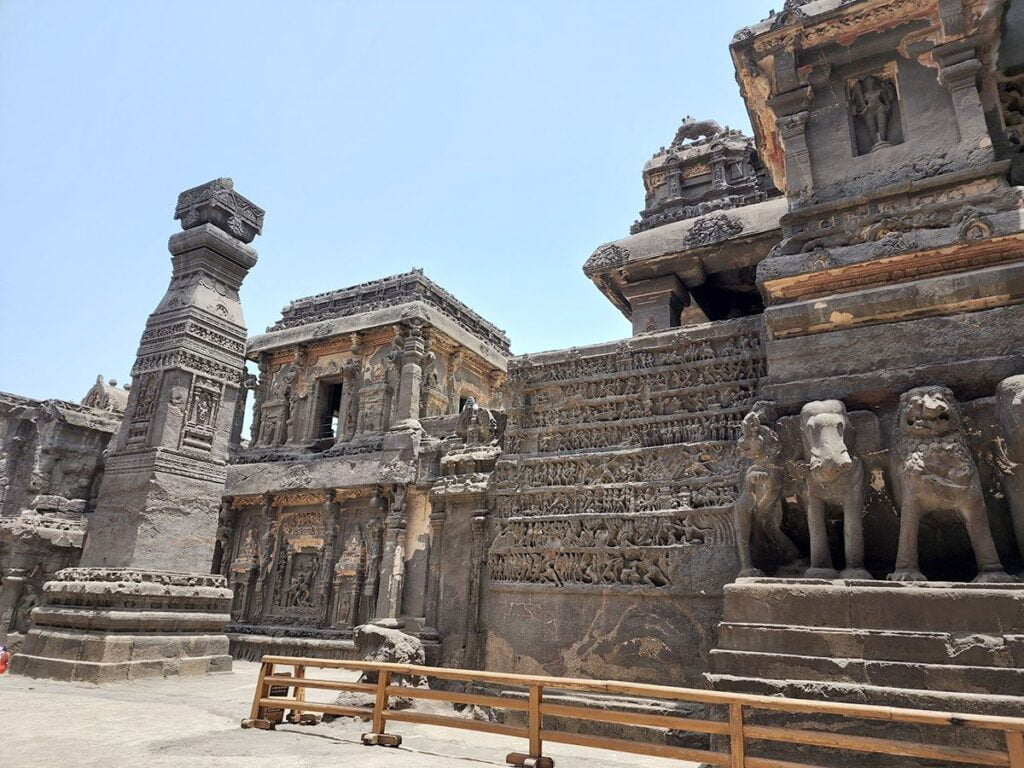
Contents
- 1 Kailashnath Temple History:
- 2 Kailashnath Temple Architecture:
- 3 Kailasa Temple Mystery at Ellora Caves:
- 4 Legend of Kailashnath Temple:
- 5 Significance of Kailashnath Temple:
- 6 Myths of Kailasa Temple at Ellora:
- 7 Interesting Facts about Kailasa Temple:
- 8 Places to visit near Kailashnath Temple:
- 9 FAQ:
- 10 How to reach Kailashnath Temple Ellora Caves:
- 11 Google Maps:
Kailashnath Temple History:
The Kailasa Temple was built in the 8th century CE by the Rashtrakuta dynasty, a powerful kingdom that ruled over much of central and southern India during that time. The temple is a monolithic structure, meaning that it was carved out of a single piece of rock. The construction of the temple is estimated to have taken over 100 years and involved the labor of thousands of people.
The Kailasa Temple is a masterpiece of Dravidian architecture. The temple is a complex of three shrines, each dedicated to a different aspect of Shiva. The main shrine is dedicated to Shiva in his linga form, and is surrounded by a number of smaller shrines and mandapas (pavilions). The temple is also decorated with a number of intricate sculptures, including depictions of gods, goddesses, and mythical creatures.
The Kailasa Temple is a testament to the skill and artistry of the Rashtrakutas. It is one of the most important examples of Dravidian architecture, and is a UNESCO World Heritage Site. The temple is also a popular tourist destination, and is visited by millions of people each year.
Read More>> Vajreshwari Temple Maharashtra
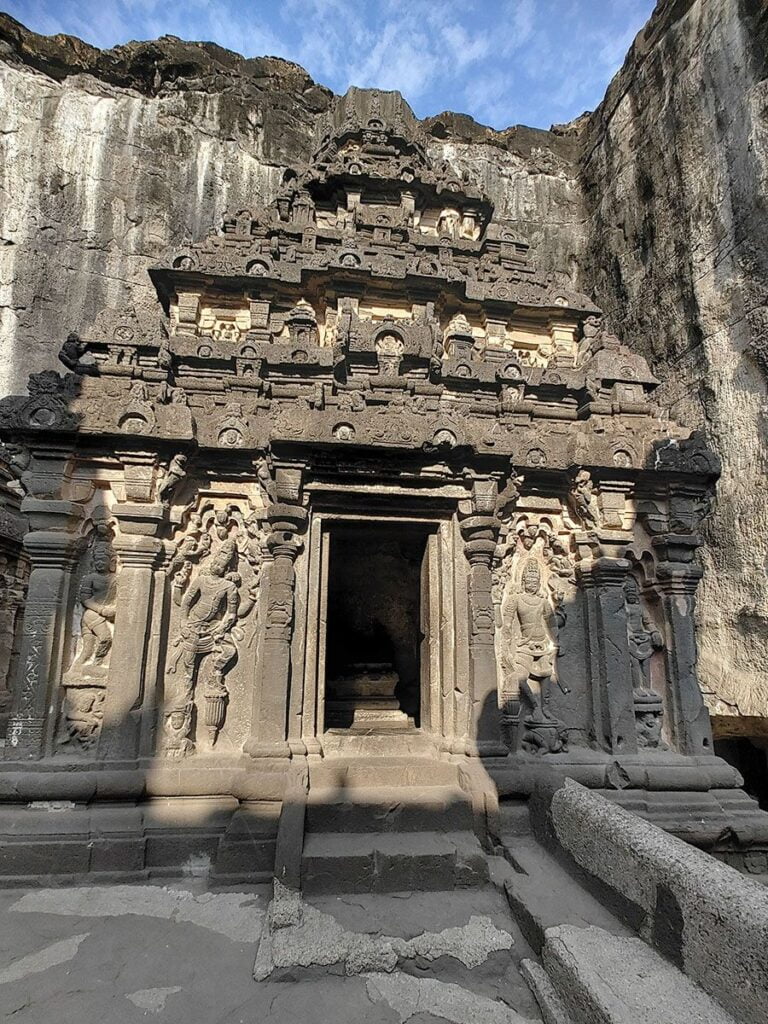
Kailashnath Temple Architecture:
- Monolithic Structure: The entire temple is carved out of a single piece of rock, specifically from the Charanandri hill in the Ellora complex. This monolithic construction is an incredible feat of ancient engineering.
- Architectural Style: The Kailashnath Temple showcases Dravidian architectural style, which is characterized by its pyramid-shaped towers or vimanas, intricate carvings, and elaborate sculptures. Dravidian architecture is prominent in the southern part of India, and the Kailashnath Temple is a unique representation of this style in the western part of the country.
- Layout: The temple is designed to resemble Mount Kailash, the abode of Lord Shiva, and features a central temple dedicated to Shiva surrounded by smaller shrines, mandapas (halls), and a large courtyard.
- Sculptures and Carvings: The temple is adorned with intricate carvings and sculptures that depict various mythological themes, stories from the Puranas, and scenes from the life of Lord Shiva. The level of detail in the carvings is extraordinary, showcasing the craftsmanship of the artisans.
- Rathas (Chariots): The temple has free-standing chariots or rathas, which are monolithic structures carved out of the same rock. These rathas are reminiscent of chariots used in processions and are positioned around the main temple.
- Mandapas: The temple complex includes several mandapas or halls with impressive columns and sculptural panels. The mandapas serve as spaces for various religious and cultural activities.
- Influence of South Indian Architecture: While the Kailashnath Temple is located in the western part of India, its architecture is heavily influenced by South Indian Dravidian style, setting it apart from the surrounding rock-cut caves that predominantly follow the Nagara style.
Read More>> Kalaram Temple Nashik
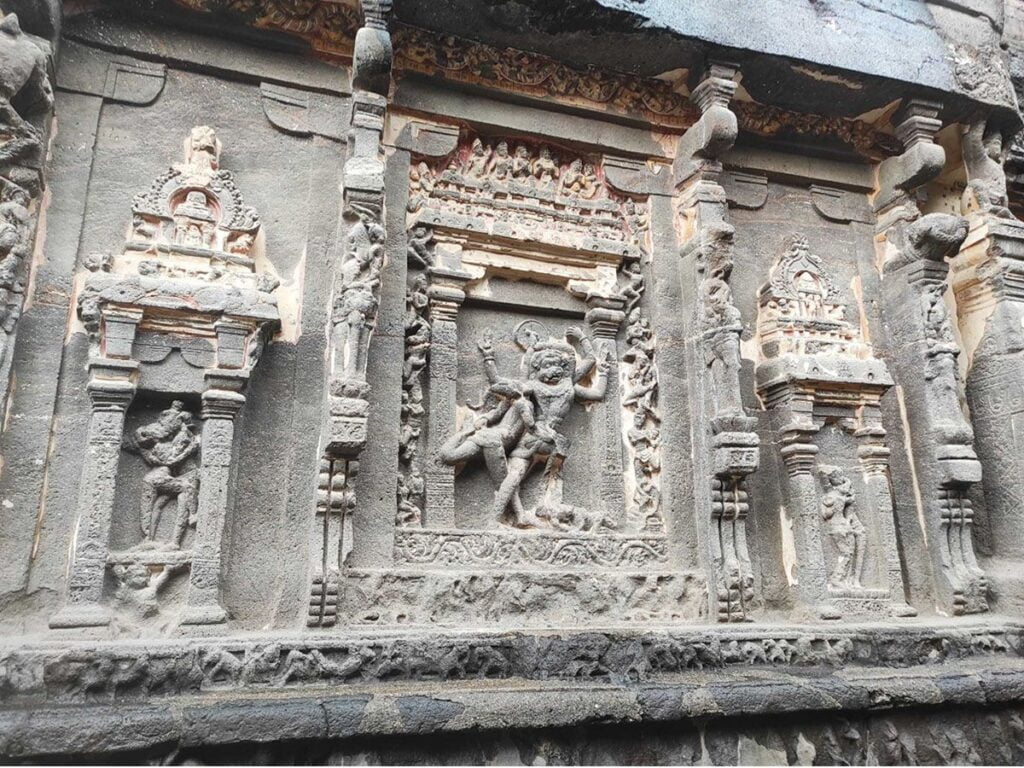
Kailasa Temple Mystery at Ellora Caves:
The Kailashnath Temple is a megalith carved out of a single rock. It is 160 feet tall, 100 feet wide, and 50 feet deep. The temple has a number of intricate carvings, including sculptures of gods, goddesses, and demons.
The Kailashnath Temple is a mystery to archaeologists. It is not known how the temple was built, given the limited technology that was available in the 8th century CE. Some archaeologists believe that the temple was built by aliens.
Here are some of the mysteries surrounding the Kailashnath Temple:
- How was the temple built?
- Who built the temple?
- When was the temple built?
- What tools were used to build the temple?
- How were the massive stones transported and lifted into place?
- How were the intricate carvings created?
The Kailashnath Temple is a testament to the ingenuity and skill of the ancient builders. It is a wonder of the world that continues to fascinate and amaze visitors from all over the globe.
Here are some of the theories that have been proposed to explain the mysteries of the Kailashnath Temple:
- The temple was built by aliens.
- The temple was built by a lost civilization.
- The temple was built using advanced technology that has since been lost.
- The temple was built by a team of highly skilled craftsmen.
Read More>> Saptashrungi Bhadrakali Temple Nasik
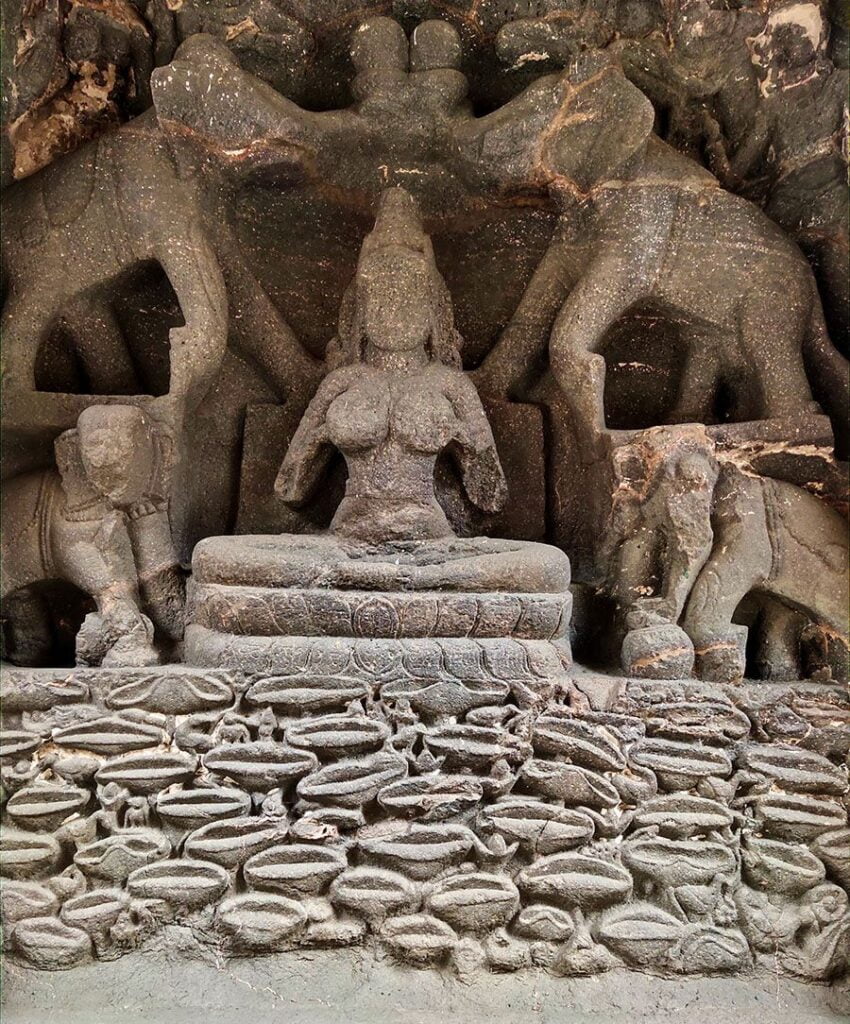
Legend of Kailashnath Temple:
There are several legends associated with the construction of the Kailashnath Temple. One popular legend tells the story of King Krishna I of the Rashtrakuta dynasty, who was suffering from a severe illness. His queen, Rani Gangadevi, prayed to Lord Shiva for her husband’s recovery, and vowed to build a temple in his honor if her prayer was answered.
According to the legend, a skilled architect named Kokasa approached the queen and promised to build the temple within a week. He started by carving the temple from the top down, a technique that was unheard of at the time. Within a week, the shikhara, or spire, of the temple was complete, and the queen was able to break her fast. The temple was named Manikeshwar after the queen, but it is more commonly known today as Kailashnath.
Another legend suggests that the temple was built by the Pandavas, the five heroes of the epic Hindu poem Mahabharata. The Pandavas are said to have spent 13 years in exile, and they built the Kailashnath Temple during this time.
Read More>> Trimbakeshwar Jyotirlinga Temple
Significance of Kailashnath Temple:
1. Kailashnath Temple, Ellora:
- Architectural Marvel: This temple is the largest rock-cut temple in the world, carved from a single piece of rock. It’s considered “the climax of the rock-cut phase of Indian architecture” due to its size, intricate details, and sculptures.
- Religious Significance: Dedicated to Lord Shiva, the temple features extensive Shaivite iconography, showcasing myths and scenes from epics like Ramayana and Mahabharata. It’s a pilgrimage site for Hindus.
- Historical Importance: Built by King Krishna I of the Rashtrakuta dynasty in the 8th century, the temple stands as a testament to the artistic and technical prowess of that era. It offers insights into the religious and cultural landscape of ancient India.
2. Kailasanathar Temple, Kanchipuram:
- Artistic Gem: This temple boasts intricate carvings showcasing Hindu art from the late 7th and early 8th centuries. It features sculptures and deities from various Hindu traditions, including Shaivism, Vaishnavism, and Shaktism.
- Architectural Innovation: The temple’s design influenced similar structures in South India. It’s also notable for housing one of the earliest and best-preserved specimens of Hindu mural art in Tamil Nadu.
- Historical Legacy: Believed to have been built by the Pallava dynasty, the temple served as a trendsetter for South Indian temple architecture. It’s also associated with legendary rulers like Raja Raja Chola I, who drew inspiration from it.
Read More>> Trikut Ganesh Temple Nanded
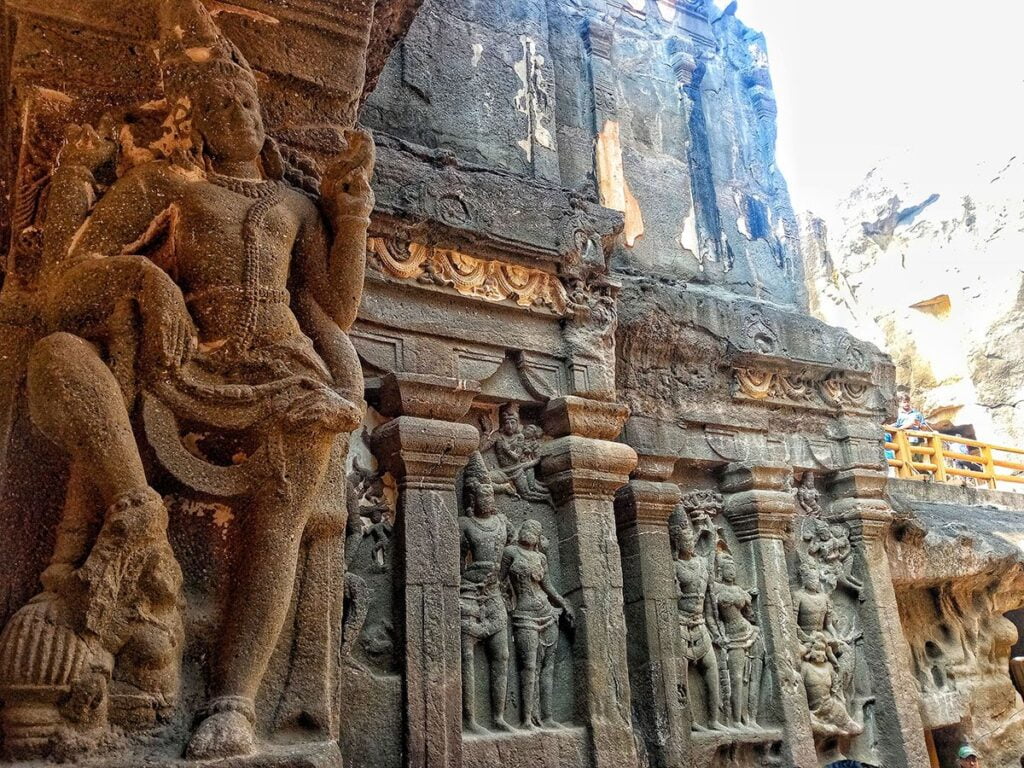
Myths of Kailasa Temple at Ellora:
1. Kailashnath Temple, Ellora:
- Myth of Ravana and Kailash: One of the most popular myths associated with the Kailashnath Temple in Ellora is the story of Ravana, the ten-headed king of Lanka, attempting to uproot Mount Kailash, the abode of Lord Shiva. According to the legend, Ravana wanted to use the mountain as a footstool for his wife, Mandodari. However, Lord Shiva pressed his toe down on the mountain, pinning Ravana beneath it. In his defeat, Ravana sang hymns in praise of Shiva, earning his forgiveness and release.
- Myth of the celestial architects: Another myth credits the construction of the Kailashnath Temple to the celestial architects, the Vishwakarmas. It is believed that they carved the temple out of a single rock face in just one night, using their divine tools and skills.
2. Kailashnath Temple, Kanchipuram:
- Myth of the five rathas: The Kailashnath Temple in Kanchipuram is one of the five rathas, or chariots, associated with Lord Shiva. Each ratha is dedicated to a different aspect of Shiva and is believed to have been built by different celestial beings. The Kailashnath Ratha is specifically dedicated to Mount Kailash and is said to represent Shiva’s abode on Earth.
- Myth of the self-manifesting Shiva Linga: The main deity of the Kailashnath Ratha is a Shiva Linga, which is believed to have self-manifested. According to the legend, a sage named Vishwamitra was performing penance to please Shiva. Pleased with his devotion, Shiva appeared before him in the form of a Linga.
Read More>> Aundha Nagnath Temple: 8th Jyothirling with Divine Serpents
Interesting Facts about Kailasa Temple:
Unique Construction:
- Carved from Top to Bottom: Unlike most rock-cut temples, Kailasa wasn’t built by adding stones, but instead carved out of a single massive rock from top to bottom. This “cut-out” technique is unique and incredibly precise, with no room for error.
- Monolithic Wonder: This 100-foot tall temple is a true monolith, meaning it’s carved entirely from a single piece of rock. No other structures like this exist on Earth!
- Massive Scale: It’s considered the largest single monolithic rock excavation in the world, even larger than the famous Parthenon in Greece. Construction required removing an estimated 200,000 tonnes of rock!
Mysteries and Intrigue:
- Exact Construction Date Unknown: Historians believe it was built in the 8th century, but no precise records exist, adding to the temple’s mystique.
- Downward Excavation Enigma: The exact method of carving from top to bottom remains a mystery, especially considering the limited technology available back then.
- Legend of White Plaster: It’s believed the temple was once covered in white plaster, resembling Mount Kailash, the heavenly abode of Lord Shiva, to whom the temple is dedicated.
Architectural Beauty:
- Rich Details and Sculptures: The temple boasts intricate carvings depicting various deities, mythological scenes, and mythical creatures, showcasing remarkable craftsmanship.
- Multi-Storeyed Marvel: Unlike most cave temples, Kailasa has two storeys, adding to its architectural complexity and grandeur.
- Religious Significance: Dedicated to Lord Shiva, the temple complex includes shrines dedicated to other deities like Vishnu and the three river goddesses Ganga, Saraswati, and Yamuna.
Places to visit near Kailashnath Temple:
- Ellora Caves: Besides the Kailasa Temple, there are 33 other caves in Ellora that showcase a mix of Hindu, Jain, and Buddhist art and architecture. The caves are divided into three groups: the Hindu caves, the Jain caves, and the Buddhist caves.
- Aurangabad: The city of Aurangabad is the base for exploring Ellora, and it has its own historical and cultural attractions. You can visit Bibi Ka Maqbara, also known as the “Mini Taj,” which is a mausoleum built in memory of Aurangzeb’s wife.
- Daulatabad Fort: This medieval fort is located around 15 kilometers from Ellora. It’s known for its impressive architecture and strategic location. The fort offers panoramic views of the surrounding landscape.
- Grishneshwar Temple: This is another important Shiva temple located near Ellora. It is one of the 12 Jyotirlingas, and devotees often visit this temple as part of a pilgrimage.
- Khuldabad: A historical town known for housing the tomb of Aurangzeb, Khuldabad has historical significance and is considered a sacred place. It’s around 30 kilometers from Ellora.
- Shirdi: If you’re interested in spiritual destinations, Shirdi is a famous pilgrimage site associated with Sai Baba. It’s a bit farther from Ellora (about 130 kilometers), but it could be worth a visit if you have the time.
- Ajanta Caves: While Ajanta Caves are not exactly near Ellora, they are another UNESCO World Heritage Site, famous for their ancient Buddhist cave paintings and sculptures. Ajanta Caves are approximately 100 kilometers away and can be visited on a separate day trip.
FAQ:
- What is Kailasa Temple?
- Kailasa Temple is an ancient Hindu temple dedicated to Lord Shiva. It is renowned for being one of the largest rock-cut temples in the world and is a UNESCO World Heritage Site.
- Where is Kailasa Temple located?
- The Kailasa Temple is situated in the Ellora Caves complex, near the village of Ellora in the Aurangabad district of Maharashtra, India.
- Who built Kailasa Temple?
- The construction of the Kailasa Temple is attributed to the Rashtrakuta king Krishna I, who ruled from 756 to 773 AD. However, the exact details of its construction are not well-documented.
- When was Kailasa Temple built?
- The construction of the Kailasa Temple is believed to have taken place during the 8th century, between the 7th and 8th centuries AD.
- How was Kailasa Temple carved?
- The temple was carved vertically downwards from a single rock, as opposed to the traditional method of carving horizontally. The construction involved removing a massive volume of rock to create the temple complex, which includes the main shrine, surrounding structures, and intricate carvings.
- What is the architectural style of Kailasa Temple?
- The Kailasa Temple exhibits Dravidian architectural features and is considered a masterpiece of rock-cut architecture. It showcases various intricate carvings, including depictions of Hindu deities, mythological scenes, and ornate detailing.
- How big is Kailasa Temple?
- The temple complex is colossal, with a height of about 32 meters (approx. 105 feet). The main temple structure itself is around 46 meters (approx. 150 feet) wide by 33 meters (approx. 108 feet) long.
- Why is Kailasa Temple significant?
- Kailasa Temple is significant for its architectural grandeur, religious importance, and historical value. Its unique construction, impressive sculptures, and religious symbolism make it a prominent cultural and heritage site.
- Can visitors explore Kailasa Temple?
- Yes, the Kailasa Temple is open to visitors. The Ellora Caves, including the Kailasa Temple, attract tourists, historians, and archaeologists from around the world.
How to reach Kailashnath Temple Ellora Caves:
1. By Air:
- The nearest airport is Aurangabad Airport (Chikkalthana Airport), which is well-connected to major cities in India. From the airport, you can hire a taxi or take a bus to reach the Ellora Caves complex.
2. By Train:
- Aurangabad has a railway station, which is well-connected to major cities in India. From the railway station, you can hire a taxi or take a bus to reach Ellora.
3. By Road:
- Aurangabad is well-connected by road, and you can reach there by bus or private vehicle. The Maharashtra State Road Transport Corporation (MSRTC) operates buses that connect Aurangabad with various cities in the state.
4. Local Transportation:
- Once you reach Aurangabad, you can hire a taxi or use local buses to reach the Ellora Caves complex. The distance between Aurangabad and Ellora is approximately 30 kilometers.
5. Entrance to Ellora Caves:
- After reaching the Ellora Caves complex, you will find a ticket counter where you can purchase an entry ticket. The Kailasa Temple is one of the prominent structures within the Ellora Caves.

One Comment